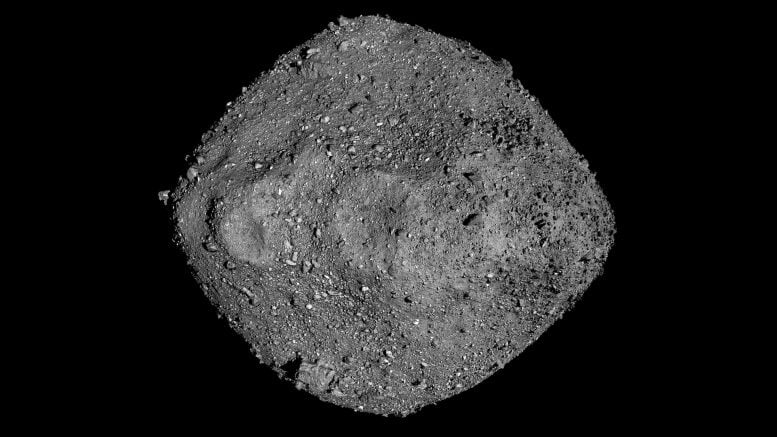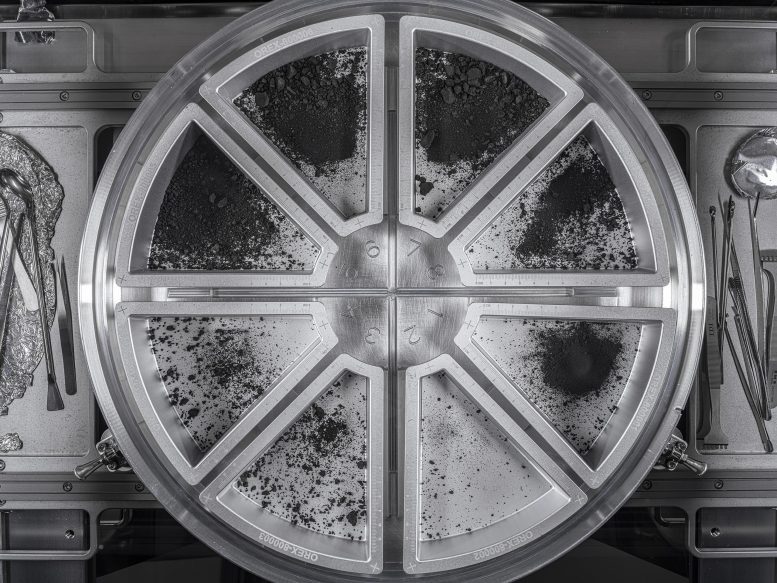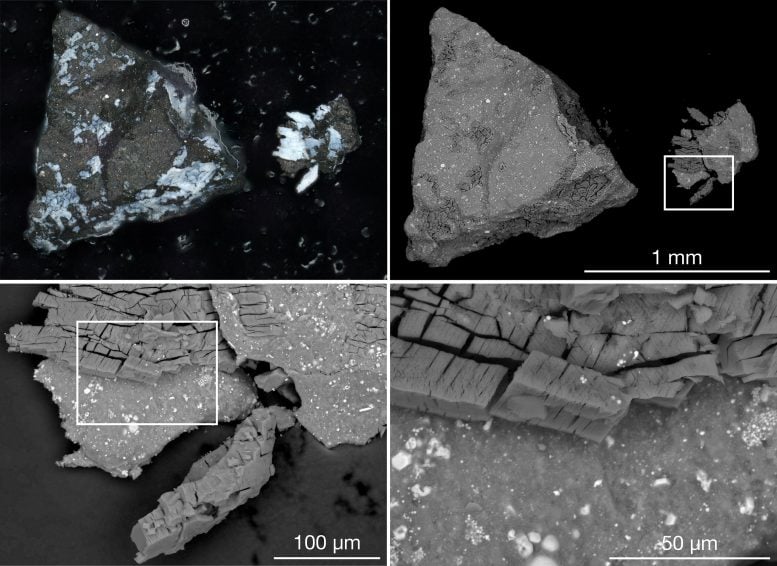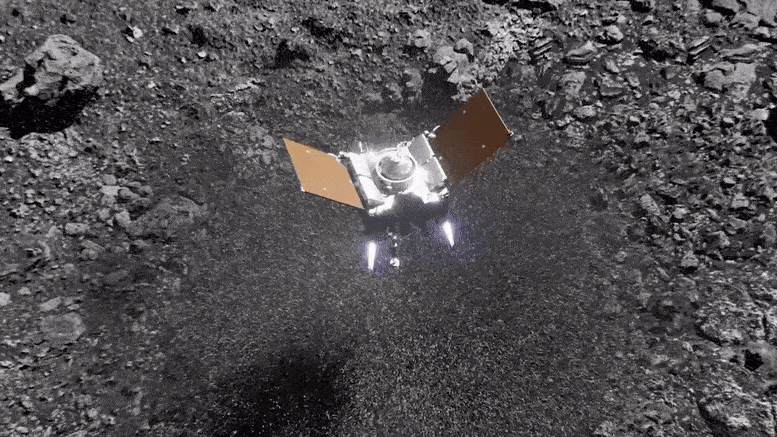A microscope image of a dark Bennu particle, about a millimeter long, with a bright phosphate crust. On the right is a smaller fragment that broke off. Credit: From Lauretta & Connolly et al. (2024) Meteoritics and Planetary Sciencedoi:10.1111/maps.14227
Analysis of a sample from the asteroid Bennu found essential components of life and hints of an aqueous past, providing insights into the origins of the solar system and prebiotic chemistry.
- Early analysis of the Bennu asteroid sample returned by NASAS ‘ OSIRIS-REx mission has discovered dust rich in carbon, nitrogen and organic compounds, all of which are essential ingredients for life as we know it. Dominated by clay minerals, particularly serpentine, the sample reflects the type of rock found at mid-ocean ridges on Earth.
- The magnesium-sodium phosphate found in the sample hints that the asteroid may have broken off from an ancient, small, primitive oceanic world. The phosphate was a surprise to the team because the mineral had not been detected by the OSIRIS-REx spacecraft while on Bennu.
- While a similar phosphate was found in the Ryugu asteroid sample submitted by JAXA(Japan Aerospace Exploration Agency) Hayabusa2 mission in 2020, the magnesium-sodium phosphate discovered in the Bennu sample is notable for its purity (ie, lack of other materials included in the mineral) and its grain size, unprecedented. in each meteorite sample.

This mosaic of Bennu was created using observations made by NASA’s OSIRIS-REx spacecraft that was in close proximity to the asteroid for more than two years. Credit: NASA/Goddard/University of Arizona
Discoveries from the composition of the asteroid Bennu
Scientists have eagerly awaited the opportunity to dig into the pristine 4.3-ounce (121.6-gram) asteroid Bennu sample collected by NASA’s OSIRIS-REx mission (Origin, Spectral Interpretation, Source Identification, and Security – Regolith Explorer) on Earth. last fall. They hoped the material would hold secrets of the solar system’s past and prebiotic chemistry that could have led to the origin of life on Earth. An early analysis of the Bennu sample, recently published in Meteoritics and Planetary Scienceshows that this excitement was warranted.
The OSIRIS-REx sample analysis team found that Bennu contains the original ingredients that formed our solar system. Asteroid dust is rich in carbon and nitrogen, as well as organic compounds, all of which are essential ingredients for life as we know it. The sample also contains magnesium-sodium phosphate, which was a surprise to the research team because it was not seen in remote sensing data collected by the spacecraft on Bennu. Its presence in the sample hints that the asteroid may have broken off from a small, primitive, oceanic world long gone.

A view of the eight sample trays containing the final material from asteroid Bennu. Dust and rocks were poured into the tray from the top plate of the Touch-and-Go Sampling Acquisition Mechanism (TAGSAM). 51.2 grams were collected from this spill, bringing the final mass of the asteroid sample to 121.6 grams. Credit: NASA/Erika Blumenfeld & Joseph Aebersold
Analysis of the Bennu sample revealed intriguing insights into the asteroid’s composition. Dominated by clay minerals, particularly serpentine, the sample reflects the type of rock found at mid-ocean ridges on Earth, where material from the mantle, the layer beneath the Earth’s crust, meets water.
This interaction not only results in the formation of clay; It also forms a variety of minerals such as carbonates, iron oxides, and iron sulfides. But the most unexpected discovery is the presence of soluble phosphates in water. These compounds are components of the biochemistry for all life known on Earth today.
While a similar phosphate was found in the asteroid Ryugu sample delivered by JAXA’s (Japan Aerospace Exploration Agency) Hayabusa2 mission in 2020, the magnesium-sodium phosphate discovered in the Bennu sample stands out for its purity—that is, the absence of of other materials in the mineral – and its grain size, unprecedented in any meteorite sample.

A small portion of the Bennu asteroid sample returned by NASA’s OSIRIS-REx mission, shown in microscope images. The top left panel shows a dark Bennu particle, about a millimeter long, with a bright phosphate outer crust. The other three panels show progressively enlarged images of a fragment of the particle splitting along a bright vein containing phosphate, captured by a scanning electron microscope. Credit: From Lauretta & Connolly et al. (2024) Meteoritics and Planetary Sciencedoi:10.1111/maps.14227
The finding of magnesium-sodium phosphates in the Bennu sample raises questions about the geochemical processes that concentrated these elements and provides valuable clues about Bennu’s historical conditions.
“The presence and condition of phosphates, along with other elements and compounds in Bennu, suggest an aqueous past for the asteroid,” said Dante Lauretta, lead author of the paper and principal investigator for OSIRIS-REx at the University of Arizona. Tucson. “Bennu could potentially have once been part of a wetter world. However, this hypothesis requires further investigation.”
“OSIRIS-REx gave us exactly what we hoped for: a large, pristine asteroid sample rich in nitrogen and carbon from a once-wet world,” said Jason Dworkin, a co-author on the paper and OSIRIS-REx project scientist at Goddard Space of NASA. Flight Center in Greenbelt, Maryland.

NASA’s OSIRIS-REx spacecraft is leaving the surface of asteroid Bennu after collecting a sample. Credit: NASA Goddard Space Flight Center/CI Lab/SVS
Despite its possible history of interaction with water, Bennu remains a chemically primitive asteroid, with elementary dimensions closely resembling those of the Sun.
“The sample we returned is the largest reservoir of unchanged asteroid material on Earth right now,” Lauretta said.
This composition provides a glimpse into the early days of our solar system, over 4.5 billion years ago. These rocks have maintained their original state, neither melting nor solidifying since their inception, affirming their ancient origins.
The team has confirmed that the asteroid is rich in carbon and nitrogen. These elements are essential to understanding the environments where Bennu’s materials arose and the chemical processes that transformed simple elements into complex molecules, potentially laying the foundations for life on Earth.
“These findings underscore the importance of collecting and studying material from asteroids like Bennu — especially the low-density material that would normally burn up upon entering Earth’s atmosphere,” Lauretta said. “This material holds the key to unraveling the complex processes of solar system formation and the prebiotic chemistry that may have contributed to the emergence of life on Earth.”
Dozens of other laboratories in the United States and around the world will receive portions of the Bennu sample from NASA’s Johnson Space Center in Houston in the coming months, and many more scientific papers describing Bennu sample analyzes are expected in the coming years. by the OSIRIS-REx Sample Analysis Team.
“The Bennu samples are extremely beautiful extraterrestrial rocks,” said Harold Connolly, co-author of the paper and OSIRIS-REx mission sample scientist at Rowan University in Glassboro, New Jersey. “Each week, analysis by the OSIRIS-REx Sample Analysis Team provides new and sometimes surprising findings that are helping to place important constraints on the origin and evolution of Earth-like planets.”
Launched on September 8, 2016, the OSIRIS-REx spacecraft traveled to the near-Earth asteroid Bennu and collected a sample of rocks and dust from the surface. OSIRIS-REx, the first US mission to collect a sample from an asteroid, delivered the sample to Earth on September 24, 2023.
Reference: “Asteroid (101955) Bennu in the laboratory: Characteristics of the sample collected by OSIRIS-REx” by Dante S. Lauretta, Harold C. Connolly, Joseph E. Aebersold, Conel M. O’D. Alexander, Ronald-L. Ballouz, Jessica J. Barnes, Helena C. Bates, Carina A. Bennett, Laurinne Blanche, Erika H. Blumenfeld, Simon J. Clemett, George D. Cody, Daniella N. DellaGiustina, Jason P. Dworkin, Scott A. Eckley, Dionisis I. Foustoukos, Ian A. Franchi, Daniel P. Glavin, Richard C. Greenwood, Pierre Haenecour, Victoria E. Hamilton, Dolores H. Hill, Takahiro Hiroi, Kana Ishimaru, Fred Jourdan, Hannah H. Kaplan, Lindsay P. Keller, Ashley J. King, Piers Koefoed, Melissa K. Kontogiannis, Loan Le, Robert J. Macke, Timothy J. McCoy, Ralph E. Milliken, Jens Najorka, Ann N. Nguyen, Maurizio Pajola, Anjani T. Polit, Kevin Righter, Heather L. Roper, Sara S. Russell, Andrew J. Ryan, Scott A. Sandford, Paul F. Schofield, Cody D. Schultz, Laura B. Seifert, Shogo Tachibana, Kathie L. Thomas-Keprta, Michelle S. Thompson, Valerie Tu, Filippo Tusberti, Kun Wang, Thomas J. Zega, CWV Wolner and, 26 June 2024, Meteoritics and Planetary Science.
DOI: 10.1111/maps.14227
NASA’s Goddard Space Flight Center in Greenbelt, Maryland, provided overall mission management, systems engineering, and mission safety and security for OSIRIS-REx. Dante Lauretta of the University of Arizona, Tucson, is the principal investigator. The university leads the science team and the planning of the science observation and data processing of the mission. Lockheed Martin Space in Littleton, Colorado, built the spacecraft and provided flight operations. Goddard and KinetX Aerospace were responsible for the navigation of the OSIRIS-REx spacecraft. Curation for OSIRIS-REx takes place at NASA Johnson. International partnerships on this mission include the OSIRIS-REx Laser Altimeter instrument from CSA (Canadian Space Agency) and the asteroid sample science collaboration with JAXA’s Hayabusa2 mission. OSIRIS-REx is the third mission in NASA’s New Frontiers Program, managed by NASA’s Marshall Space Flight Center in Huntsville, Alabama, for the agency’s Science Mission Directorate in Washington.